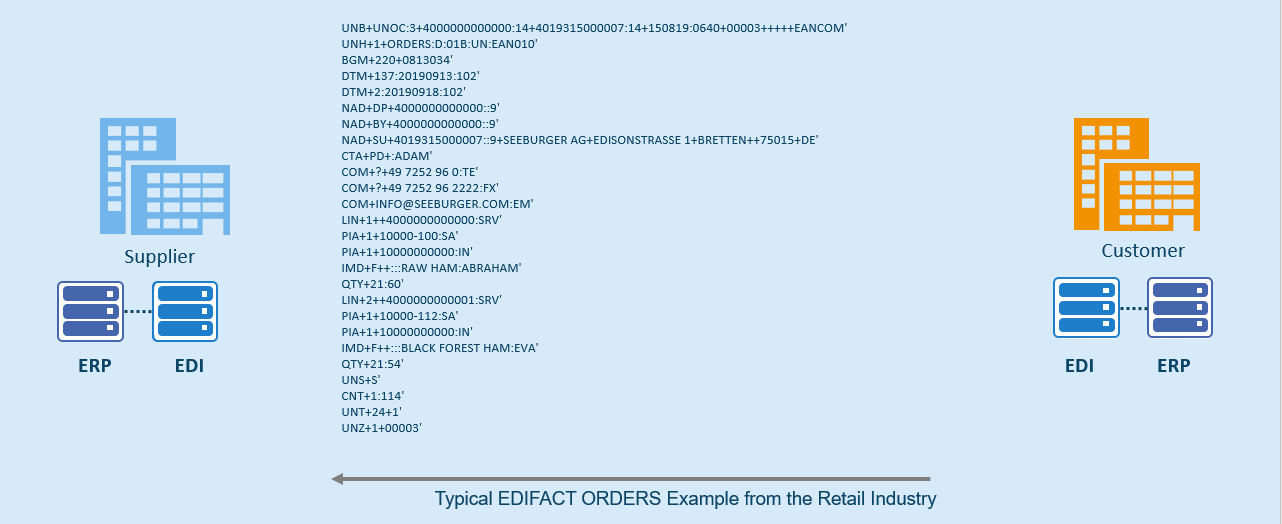
What is an EDIFACT ORDERS Message?
The UN/EDIFACT ORDERS is a Purchase Order Format sent from customers to suppliers, asking for goods or services. An EDI (Electronic Data Interchange) purchase order message is a core business document for automated B2B document exchange that comes along with most EDI workflows.
The use of the EDIFACT ORDERS Message
Buying organizations use EDI purchase orders to order services or goods and direct them to distribution centers, stores or their end consumers.
The ORDERS format is the purchase order document using EDI messaging standards based on EDIFACT as a common EDI standard format.
The purchase order is normally created in the ERP system of the customer in an ERP-specific data format. Using an EDI solution this internal format then is converted into the EDIFACT ORDERS format. After the conversion, the message is sent to the supplier placing an order for goods or services.
How does a typical EDIFACT ORDERS Structure look like?

The purchase order information follows a structure of so called segments and elements specified for EDIFACT ORDERS. An EDI purchase order message document like EDIFACT ORDERS is sent, received, and processed by an EDI solution (either using EDI software on-premises or in making use of an EDI Cloud Service). To ensure a smooth, automated process, it is mandatory to follow the accepted EDIFACT ORDERS standards or otherwise this may create errors or even prevent the document from ever arriving at the supplier.
Content of a typical EDIFACT ORDERS Message contains:
- Ordered item associated cost
- Ordered quantities
- Invoicing information like date and purchase order number
- Target address (single or multiple locations to send to like for cross-dock orders)
- Additional logistics instructions
- Details for the logistics provider
Processing of the EDIFACT ORDERS Message
Upon receiving the EDIFACT ORDERS message, the supplier will validate the document against the EDIFACT ORDERS standards specification and provide a functional acknowledgement (EDIFACT CONTROL). The objective of such a functional acknowledgment is the confirmation of the purchase order receipt.
Documents that are exchanged between customer and supplier EDI trading partners follow a standard sequence of business processes, which varies depending on the type of vertical industry. The figure below shows the role of an EDIFACT ORDERS message and which other message types are used in a retail scenario:

What are the equivalents of EDIFACT ORDERS in other EDI Standard Formats?
EDIFACT is the standard proposed by the UN, and is widespread in Europe as well as most parts of Asia. UN/EDIFACT uses a single ORDERS document to cover all purchase order messages.
Depending on industries and geographies other EDI message standards might be preferred, for example:
The ANSI X12 standard is widely used in North America, and has two EDI purchase order document types, the 850 (CPG Retail) and 875 (for fresh foods like grocery). TRADACOMS is a standard in the UK retail sector still in use and the TRADACOMS purchase order message is called ORDHDR.
Typical Errors when using the EDIFACT ORDERS Message
The efficiency of the day-to-day EDI workflow depends on the quality of the data involved. Typical challenges are new sets of data in the customer ERP system, which are not known in the supplier ERP system in time and result in conflicts with the ORDERS Purchase Order Message:
- New addresses for shipment: With a new ship-to address that is not present in the supplier system yet.
- New items: A customer may include new items or item numbers on a purchase order message which are not yet available in the supplier’s system.
- Different Pricing Labels: Errors due to pricing labels may occur if a customer states a different price on the purchase order message than the one agreed to by the supplier.
Benefits using EDI and the EDIFACT ORDERS Message
There are many benefits using EDI for both the customer and the supplier
- Process orders faster
- Better supplier ratings due to less chargebacks
- Cost reduction because of more efficient sales processing
- Place orders faster
- Reduce capital allocation due to lower inventory levels
- Cost reduction due to streamlined and automated purchasing
Automate the EDIFACT ORDERS Purchase Order Message with flexible operating models
Evaluate all possibilities how to operate EDI in a better way. With SEEBURGER you have plenty of options: The SEEBURGER EDI solution can be used on-premises operated in your data center or can be run as an EDI Cloud Service in the SEEBURGER Cloud. Another alternative is the operation in a public cloud environment like the ones from Google, Azure, AWS etc.









